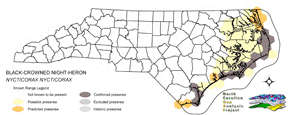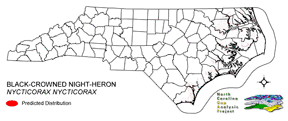
| Taxa: |
| Order: |
| Family: |
| Aves |
| Ciconiiformes |
| Ardeidae |
| NatureServe Global Rank: |
| NatureServe State (NC) Rank: |
| G5 |
| S4B,S4N |
| Federal Status: |
| NC State Status: |
| --- |
| --- |


| Land Unit |
| US Fish & Wildlife Service |
| US Forest Service |
| US National Park Service |
| US Department of Defense |
| NC State Parks |
| NC University System |
| NC Wildlife Res. Com. |
| NC Forest Service |
| NC Div. of Coastal Mgmt. |
| Local Governments |
| Non-Governmental Org. |
| Other Public Lands |
| Private Lands |
| GAP Status 1-2 |
| All Protected Lands |
| Statewide |
| Hectares |
| 4,646.79 |
| 965.25 |
| 2,515.95 |
| 407.97 |
| 488.79 |
| 118.44 |
| 1,184.85 |
| 0.00 |
| 287.91 |
| 16.83 |
| 1,228.77 |
| 3.69 |
| 48,037.32 |
| 7,131.78 |
| 11,878.11 |
| 59,902.56 |
| Acres |
| 11,482.47 |
| 2,385.18 |
| 6,217.05 |
| 1,008.12 |
| 1,207.83 |
| 292.67 |
| 2,927.83 |
| 0.00 |
| 711.44 |
| 41.59 |
| 3,036.36 |
| 9.12 |
| 118,702.78 |
| 17,623.01 |
| 29,351.44 |
| 148,022.42 |
| % of Dist. on |
| Prot. Lands |
| 39.1 % |
| 8.1 % |
| 21.2 % |
| 3.4 % |
| 4.1 % |
| 1.0 % |
| 10.0 % |
| 0.0 % |
| 2.4 % |
| 10.3 % |
| 10.3 % |
| < 0.1 % |
| 0.2 % |
| 60.0 % |
| ----- |
| ----- |
| % of Dist. on |
| All Lands |
| 7.8 % |
| 1.6 % |
| 4.2 % |
| 0.7 % |
| 0.8 % |
| 0.2 % |
| 2.0 % |
| 0.0 % |
| 0.5 % |
| < 0.1 % |
| 2.1 % |
| < 0.1 % |
| 80.2 % |
| 11.9 % |
| ----- |
| ----- |
|
Resident along the coast plain, sandhills, barrier islands, and an accidental breeder further inland (Hamel 1992, Potter et al 1980). Occurs in fresh, salt, and brackish water habitats such as marshes, swamps, ponds, lakes, and bays (Ehrlich et al 1988, Hamel 1992, Harrison 1975). Breeding areas are usually close to water in a swampy location that has moderate to dense woods or shrub thickets (Hamel 1992). Night herons forage along the shores of bodies of water (Hamel 1992). Nests are built in dense vegetation, shrubs, or trees, and therefore can vary in height from ground level to 160 feet, although most average below 10 feet (Erhlich et al 1988, Harrison 1975, Potter et al 1980). Even though most nests are composed of sticks, twigs, reeds, and lined with finer materials, the structure of the nest is highly variable, and range from frail or flimsy to quite substantial (Erhlich et al 1988, Harrison 1975, Potter et al 1980). Black-crowned night herons forage in shallow water for fish, snakes, amphibians, or other aquatic animals (Hamel 1992, Potter et al 1980). NATURE SERVE GLOBAL HABITAT COMMENTS: Marshes, swamps, wooded streams, mangroves, shores of lakes, ponds, lagoons; salt water, brackish, and freshwater situations. Roosts by day in mangroves or swampy woodland. Eggs are laid in a platform nest in groves of trees near coastal marshes or on marine islands, swamps, marsh vegetation, clumps of grass on dry ground, orchards, and in many other situations. Nests usually with other heron species. |
| Code | Name | Description | NC Natural Heritage Program Equivalent |
| 124 | Maritime Scrubs and Tidal Shrublands | Coastal shrubs including wax-myrtle, swamp rose, alder, yaupon, and greenbriar. | Maritime Shrubs, Salt Shrub |
| 75 | Tidal Swamp Forest | Swamp tupelo dominated forest with or without black tupelo and/or cypress trees. Restricted to the tidal zones in the coastal plain. May have inclusions of coastal red cedar woodlands. | Tidal cypress - gum swamp |
| 121 | Maritime Pinelands | Loblolly forests and woodlands of the outer coastal plain. | Estuarine Fringe Loblolly Pine Forest |
| 17 | Maritime Forests and Hammocks | Maritime forests and woodlands dominated by live or sand laurel oak. Estuarine Fringe forests dominated by loblolly pine. | Coastal Fringe Evergreen Forest, Maritime Deciduous Forest, Maritime Deciduous Forest |
| 126 | Interdune Wooded Depression Swamp | Includes swamps dominated by sweetbay and swampbay or dogwood dominated forests. | Maritime Shrub Swamp, Maritime Swamp Forest |
| 380 | Coastal Plain Fresh Water Emergent | Emergent vegetation in fresh water seepage bogs, ponds and riverbeds of the coastal plain. Includes alliances dominated by sedges, eelgrass, as well as cane found in unforested cane-brakes. | Small Depression Pond, Sandhill Seep, Floodplain Pool, Unforested Floodplain Canebrake, Riverscour Prairies, Vernal Pools |
| 173 | Coastal Plain Riverbank Shrubs | Shrub dominated riverbanks, commonly dominated by willows and/or alders. | Sand and Mud Bar |
| 50 | Coastal Plain Mixed Bottomland Forests | Includes forests dominated by a variety of hardwood species, including sweetgum, cottonwood, red maple. | Coastal Plain Bottomland Hardwood (in part), Coastal Plain Levee Forest |
| 49 | Coastal Plain Oak Bottomland Forest | Bottomland forests dominated by deciduous oak alliances. Oaks represented can include swamp chestnut, cherrybark, willow, and/or overcup oak. Inclusions of loblolly pine temporarily flooded forests occur in patches. Hydrology is temporarily to seasonally flooded. | Coastal Plain Bottomland Hardwoods (in part) blackwater subtype, brownwater subtype |
| 30 | Cypress-Gum Floodplain Forests | Swamps dominated by black or swamp tupelo with or without Taxodium. Seasonally to semi-permanently flooded hydrology. | Cypress-Gum Swamps |
| 78 | Pond-Cypress - Gum Swamps, Savannas and Lakeshores | Cypress dominated swamps and lakeshores. Can include bays dominated by pond cypress or shorelines of coastal plain lakes with a narrow band of cypress. | Non-riverine Swamp Forest, Natural Lakeshores (in part) |
| 385 | Oak Bottomland Forest and Swamp Forest | The swamp chestnut oak, cherrybark oak, shumard oak and sweetgum alliance is one representative. Other alliances are dominated by water, willow, and overcup oaks. Swamp forests can be dominated by sweetgum, red maple, and black gum being dominant. Loblolly can occur in combination with sweetgum and red maple, or with tulip poplar. Includes saturated and semi- to permanently flooded forests in the mountains. | Piedmont/Mountain Bottomland Forest, Piedmont/Mountain Swamp Forest |
| 202 | Residential Urban | Includes vegetation interspersed in residential areas. Includes lawns, mixed species woodlots, and horticultural shrubs. Vegetation accounts for between 20 - 70% of the cover. | No equivalent |
| 8 | Open water | Open water without aquatic vegetation. | No equivalent |
|
Allen, R. P. and F.P. Mangles. 1940. Studies of the nesting behavior of the black-crowned night heron. Proc. Linnaean Soc. New York 50-51:1-28.
Custer, T. W., G. L. Hensler, and T. E. Kaiser. 1983. Clutch size, reproductive success, and organochlorine contaminants in Atlantic coast black-crowned night herons. Auk 100:699-710. DeMauro, M. M. 1993. Colonial nesting bird responses to visitor use at Lake Renwick heron rookery, Illinois. Natural Areas Journal 13:4-9. Engilis, A., Jr., and T. K. Pratt. 1993. Status and population trends of Hawaii's native waterbirds, 1977-1987. Wilson Bull. 105:142-158. Fleury, B. E., and T. W. Sherry. 1995. Long-term population trends of colonial wading birds in the southern United States:the impact of crayfish aquaculture on Louisiana populations. Auk 112:613-632. Ehrlich, P.R., D.S. Dobkin, and D. Wheye. 1992. Birds in jeopardy:the imperiled and extinct birds of the United States and Canada, including Hawaii and Puerto Rico. Stanford University Press, Stanford, California. 259 pp. Hamel, P. B. 1992. The land manager's guide to the birds of the south. The Nature Conservancy, Chapel Hill, North Carolina. 367 pp + several appendices. Herkert, J. R., editor. 1992. Endangered and threatened species of Illinois:status and distribution. Vol. 2:Animals. Illinois Endangered Species Protection Board. iv + 142 pp. Scott, J. M., et al. 1988. Conservation of Hawaii's vanishing avifauna. BioScience 38:238-253. Palmer, R. S. (editor). 1962. Handbook of North American birds. Vol. 1. Loons through flamingos. Yale University Press, New Haven. 567 pp. Harrison, H.H. 1975. A field guide to bird's nests in the U.S. east of the Mississippi River. Houghton Mifflin Company, Boston, Massachusetts. 257 p. Payne, R. B., and C. J. Risley. 1976. Systematics and evolutionary relationships among the herons (Ardeidae). Univ. Michigan Mus. Zool., Misc. Publ. No. 150. 115 pp. Potter, E. F., J. F. Parnell, and R. P. Teulings. 1980. Birds of the Carolinas. Univ. North Carolina Press, Chapel Hill. 408 pp. Terres, J.K. 1980. The Audubon Society encyclopedia of North American birds. Alfred A. Knopf, New York. Berger, A.J. 1981. Hawaiian Birdlife. Second Edition. University of Hawaii Press, Honolulu, Hawaii. xv + 260 pp. American Ornithologists' Union (AOU), Committee on Classification and Nomenclature. 1983. Check-list of North American Birds. Sixth Edition. American Ornithologists' Union, Allen Press, Inc., Lawrence, Kansas. National Geographic Society (NGS). 1983. Field guide to the birds of North America. National Geographic Society, Washington, D.C. Hilty, S.L., and W.L. Brown. 1986. A guide to the birds of Colombia. Princeton University Press, Princeton, New Jersey. 836 pp. Pratt, H.D., P.L. Bruner, and D.G. Berrett. 1987. A field guide to the birds of Hawaii and the tropical Pacific. Princeton University Press, Princeton, New Jersey. 409 pp. + 45 plates. Ehrlich, P.R., D.S. Dobkin, and D. Wheye. 1988. The birder's handbook:a field guide to the natural history of North American birds. Simon and Shuster, Inc., New York. xxx + 785 pp. Root, T. 1988. Atlas of wintering North American birds:An analysis of Christmas Bird Count data. University of Chicago Press. 336 pp. Spendelow, J.A., and S.R. Patton. 1988. National atlas of coastal waterbird colonies in the contiguous United States:1976-1982. U.S. Fish and Wildlife Service, Biological Report 88(5). x + 326 pp. Stiles, F.G., and A.F. Skutch. 1989. A guide to the birds of Costa Rica. Comstock Publ. Associates, Cornell University Press, Ithaca, New York. 511 pp. |
For more information please contact them at:
NC-GAP Analysis Project
Dept. of Zoology, NCSU
Campus Box 7617
Raleigh, NC 27695-7617
(919) 513-2853
www.basic.ncsu.edu/ncgap